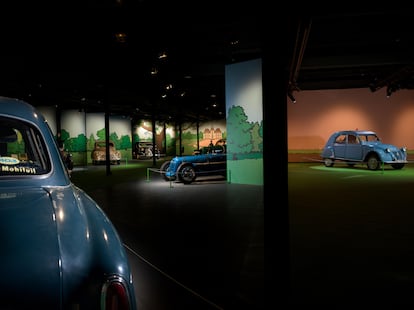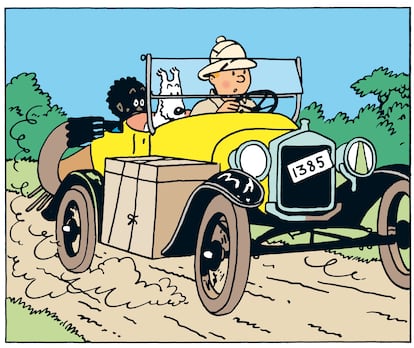In their first adventure they already led to the Russia of Stalin in a racing car. Shortly after they discovered Congo, this time at the wheel of a Ford T, the first vehicle produced in series by the American manufacturer. In Chicago they escaped from the gangsters who chased them in a Bugatti 35, a sporting mythical of the French firm in the 20s. In the center of the adventures were Tintin and his dog Niceheroes of the Belgian cartoonist saga Hergé (1907-1983), in which there was often a third protagonist.
“In the universe of Hergé, the car, more than an object, is a character more that is part of the stories, accompanies the readers and guides them in the adventures of Tintin,” explains Dominique Maricq, archivist of the Hergé Foundation, an organism that watches through the creator’s legacy and one of the organizers of the exhibition of the exhibition By car with tintinwhich welcomes the National Mulhouse Auto Salon, north of France.
The sample, the largest on the subject and that can be seen until November, reveals Hergé’s obsession with cars and the creative and documentation process that followed when illustrating them in the adventures of Tintin: he accumulated around 20,000 images, photos, models or publications he found in specialized magazines. A small part of this vast file can be seen in the exhibition, next to a dozen real -size classic vehicles in which they were inspired and belonging to the museum. “Hergé was born at the beginning of a century in which there were great progress in areas such as aviation or automotive. Conscious of that advance, at the time he decides to create a character like Tintin, who loves action and adventure, the car quickly becomes the ideal partner,” explains the expert during the visit to the sample.
With 31 years, Hergé managed to buy his first car: an Opel Olympia Cabriolet, which includes in the episode El Cetro de Ottokar. “During the war I hid it on a farm, because the Germans requisitioned the cars. I did not lead it much; in addition, gasoline was difficult to find at that time,” said the cartoonist, who died in 1983. He had a predilection for the Italian brands and by the Jeep, which is on several of the covers of the saga, as “in Objective: The Moon. We see to what extent this model was important for him, ”explains Maricq, which has spent months selecting the material for the sample within the Hergé document bank.
In the 24 albums of Tintin characterized 70 cars from the mid -twentieth century. One of those that can be seen at real size is the Citroën 2CV, very popular in France until the 90s and that appears in three of its albums. Hergé colored it green, although the one that was sold the most was gray. There is also Bugatti 35, another of the emblematic, or the French almicar of the 20s. “Nothing has been exposed outside of Hergé’s designs, her entire universe has been recreated, with a total loyalty and respect for the creator’s work,” explains Robert Vangeneberg, administrator of the Hergé de Tentinmaginatio Museum.
The exhibition shows the evolution in its creative process. Meticulously the models recreated thanks to the photos or models. Then he started working with a team of collaborators, in charge of refining the technique so that the real ones resemble the real ones. “In the first stories their strokes are more appreciated, but as they advance we see much more sophisticated copies, which are more precisely, but they lose a bit of spontaneity,” explains Maricq.
In a nutshell they are passive elements. Vehicles become heroes that help Tintin and Nice To escape and this becomes a pilot in persecutions. Sometimes vehicles come alive, as in The Tornasol matterwhen the two inspectors who chase Tintin deform the roof. Car races were popular, so “their presence speeds up the stories and reminds the films of the time where there are Gánster and persecutions. Tintin cars are quickly placed as protagonists of the action,” according to the expert.

It is the most ambitious exhibition that has been made on the subject. One was performed in Toulouse on Tintin and the planes and another in the Paris Museum on the ships that appear in their adventures. “The Universe of Hergé surpasses the artist. There are people who are not lover of cars or airplanes, but from Tintin. Few authors can boast of having been so present in the collective imaginary. There are images, such as those of these cars, who evoke us their universe and make us think of a tintin vignette, rather than in one of Astérix, for example,” according to the archivist.
The mythification of his objects does not occur only with the car, as Vangenebert explains: “In the exhibition there is a red armchair, which is iconic in many vignettes, although in reality he did not spend much time sitting on him. Hergé had that ability to capture the environment and translate it into images that made us understand and discover things.”
The saga, which began in 1929 with Tintin in the Soviets country and ended with Tintin and the rogues, In 1976, he told the changes of the twentieth century. Maricq says: “Hergé witnessed the time and every album is like a part of the encyclopedia in the history of the century. If Tintin existed in 2025 it would be very sensitive to ecological challenges, and if he had to travel by car, it would be a ‘green’. In great adventures Tintin and the rogueswhere he is even seen to make a yoga posture. A current album would be oriented to the great challenges of the present time. No doubt Tintin would continue to tell us the story. ”

